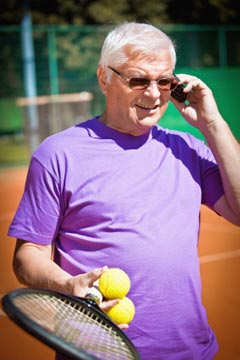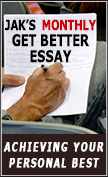January 2011:
ICING THE SERVER WHEN RECEIVING IN THE BIG MOMENTS
Professional football is mostly perceived as a very physical, violent game. All you have to do is YouTube “NFL violent hits” etc. and you’ll see what I mean, not to mention the recent recognition of the “concussion problem.” However football, despite the carnage, also has myriad psychological elements to it as well. One that has recently come to the forefront is the practice of team’s overt effort in attempting to rattle the state of mind of the opposing team’s field goal kicker. The tactic is referred to as “icing,” and involves the defensive team calling a time-out at the very last moment prior to the kicker, who is already queued up physically, mentally, and emotionally, and ready to attempt the kick when the outcome of the game is on the line.
Studies have proven that it is very effective in that kickers on average, when ”iced,” drop-off in their normal success rate by 15% - 20%! Nothing like disrupting the kicker’s preparation ritual by shutting him down and making him wait another few minutes, restart his ritual, and give him time to think some more about the ramifications of failure and the task at hand with 52 teammates, the violence dealing players who get their uniforms dirty, depending on the outcome!
In tennis, particularly in the important moments, the server experiences the same kind of pressure as the field goal kicker – the parallel is striking - particularly on points that are pivotal in deciding a game or particularly in a match’s ultimate outcome.
 Tennis rules junkies love to spout off about how the receiver must play to the pace of the server. True, but only if that’s a “reasonable” pace of the server which is most often left out of the equation, i.e. you are not expected to resign yourself to being either purposely or inadvertently “quick served” prior to being fully settled in with your own return “walk-up” and ritual.
Tennis rules junkies love to spout off about how the receiver must play to the pace of the server. True, but only if that’s a “reasonable” pace of the server which is most often left out of the equation, i.e. you are not expected to resign yourself to being either purposely or inadvertently “quick served” prior to being fully settled in with your own return “walk-up” and ritual.
During these big moments make it a point to take that little bit of extra time – that’s reasonable extra time without violating the rules of sportsmanship – and make the server wait that extra :10 seconds or so while you legitimately, for example, take a moment to fiddle with your strings to insure that the grid is properly aligned, adjust your cap or visor while toweling your forehead off with your wristband, and take the long way around to your actual receiving court position. Note: answering cell phone as depicted in the accompanying image, if you’re a particularly creative competitor, is not an option!
At the same time, since the scenario is that it’s a close match that is potentially up for grabs, you’ll have a better opportunity to settle your Self to the task at hand while you are controlling the pacing, or time in between points, and giving the server a little ice time simultaneously.
Football teams actually rehearse icing their own kickers in practice so that they can experience dealing with it and render it ineffective. Back on the tennis court, if you reverse roles and put yourself in the server’s sneakers, and you’re being iced, you can learn countermeasures from two of football’s best pressure proof kickers.
Joe Nedney of the 49ers and Atlanta’s Matt Bryant, two of the best, embrace very different but effective strategies that work for them. Bryant typically drapes a towel over his helmet, once back on the sidelines during the time-out, and doesn’t even think about the game! Instead his focus goes to his family which he explains: “I try to find a happy place.” Nedney’s approach is more combative: “You want to ice me? Great. You’re still going to lose the game and you’re going to have one less time out. That’s the only mentality you can have.”
Personally, I can recall a close match, in my final year of tournaments years ago - I was aspiring to be #1 on the Florida USTA 35's circuit and doing well - with a respected opponent of some reputation. This jerk, as it turned out that day, repeatedly insisted on walking 1-2 courts away – we were the only match playing on a bank of 4 courts at the time – to retrieve the third ball when I was serving whenever the opportunity presented itself. This guy invented icing! When I confronted him in no uncertain terms he flipped his lid – I had apparently violated his presumed sanctity – and he, in a tantrum, demanded an on-court referee. I was lucky. I then did not have to come up with a solution that day in dealing with such blatant gamesmanship. The referee went ahead and enforced that he play to a reasonable pace.
Nonetheless, pressure in sport is universally experienced. Even curlers have to deal with it – okay, that’s not really a sport is it. Nevermind. In any event, the term “mental toughness” was, in part, born out of it. Unlike the above described incident, you’ll have to be cognizant of coming up with a solution to deal with icing positively when you’re the one being made to wait. You’ll also be in control of those instances when you have an opportunity to fairly apply a bit of the icing tactic onto them.
Good luck. It’s your court, your tennis balls, and the opponent is there for you! Be selfish but be fair. Be in control, and stay in control, no matter what.
Questions and comments are welcome at anytime for all tips present and past via email.
This Tip of the Month is copyright© by Jak Beardsworth Tennis. All rights reserved. Copies may be made only with the permission of and by Jak Beardsworth. Contact him here.
Tips Archive
- May, June, 2013 JUST TALKING HEADS OR MORE [read more]
- March, April, 2013 SELF-TALK: Good, Bad, or Indifferent [read more]
- January, February, 2013 BOOK-A-MILLION: Do Tennis Players Read? [read more]
- December, 2012 THE KEY TO TOUR LEVEL BALL STRIKING: And How to Learn It [read more]
- November, 2012 ARE YOU A THUDDER, A TWANGER, OR A PINGER: Racket Dampeners [read more]
- September, October, 2012 SMART SHOTS [read more]
- July, August, 2012 TEN TOP STRESS REDUCERS [read more]
- June, 2012 MAKING YOUR LESSONS STICK [read more]
- May, 2012 THE IMPOSSIBLE: Accelerating and Decelerating Simultaneously [read more]
- April, 2012 PLAYER DISCONNECTION [read more]
- March, 2012 BENDING THE SERVE IN [read more]
- February, 2012 UNDERSTANDING TERMINOLOGY: Drill vs Clinic vs Team Practice [read more]
- January, 2012 PLAYING SCARED? [read more]
- December, 2011 CUTTING OFF THE ANGLE…VERTICALLY [read more]
- November, 2011 WHY COACHING? [read more]
- October, 2011 THE EASY BALLS ARE NOT EASY [read more]
- August/September, 2011 NEVER TOO LATE FOR OLDER DOGS [read more]
- June/July, 2011 HARD COURTS, SOFT COURTS, and YOUR BODY'S ADAPTATION [read more]
- April/May, 2011 JAW DROPPNG [read more]
- March, 2011 CLUB DOUBLES' INCREASINGLY MISSING LINK [read more]
- February, 2011 TIP 2 | POOH POOHING DOUBLES STRATEGY SESSIONS [read more]
- February, 2011 TIP 1 | CLAY TO HARD, HARD TO CLAY [read more]
- January, 2011 ICING THE SERVER WHEN RECEIVING IN THE BIG MOMENTS [read more]
- December, 2010 JOHN ISNER’S “GOOD MISS” [read more]
- November, 2010 THE MOST NEGLECTED SHOT IN THE GAME [read more]
- October, 2010 BALL BOUNCING and the SERVE [read more]
- September, 2010 TAKE YOUR EYE OFF THE BALL [read more]
- July-August, 2010 SUMMER SCHOOL COURTSIDE CRIB SHEET [read more]
- May-June, 2010 THE 2-HANDED JUMP BACKHAND: The Dumbest Shot in Tennis [read more]
- April, 2010 THE STANDING AROUND SYNDROME [read more]
- March, 2010 THE ELUSIVE SERVICE TOSS [read more]
- February, 2010 PREPARING TO START THE POINT: Serving and Receiving [read more]
- January, 2010 DEBUNKING THE MODERN GAME [read more]
- December, 2009 RELAX – IT'S JUST A RALLY BALL [read more]
- November, 2009 DEFEATING THE POACHER [read more]
- October, 2009 PRACTICE, PRACTICE, PRACTICE [read more]
- September, 2009 SERVING SUCCESS: Warming-Up vs Match Play [read more]
- August, 2009 THE SPLIT STEP: Defending the Court, Rushing the Net, and More [read more]
- July, 2009 THE THIRD GROUNDSTROKE [read more]
- June, 2009 HOW MANY HANDS DOES IT TAKE? [read more]
- May, 2009 THE MOST IMPORTANT SKILL [read more]
- April, 2009 PLAYING IN THE FLORIDA WIND [read more]
- March, 2009 Letting them Play for Peak Performance in Clubland [read more]
- February, 2009 SUPPORTING YOUR GAME [read more]
- January, 2009 RESPECTING THE GAME: Top 10 Do's & Don'ts [read more]
- December, 2008 Getting the Warm-up Right [read more]
- November, 2008 Visualize...Realize: The Mind Body Connection [read more]
- October, 2008 Reading Their Mail [read more]


